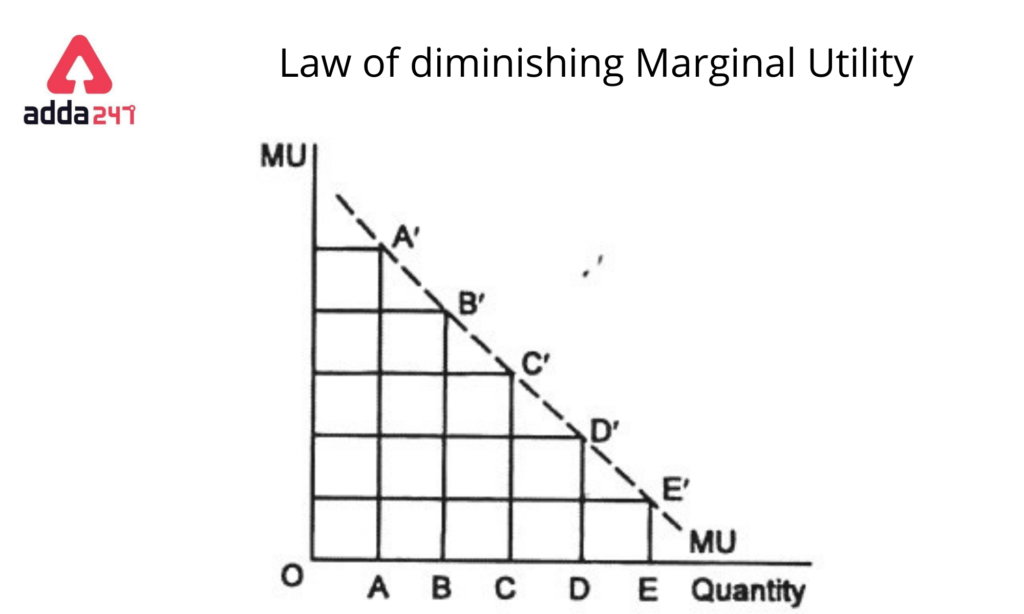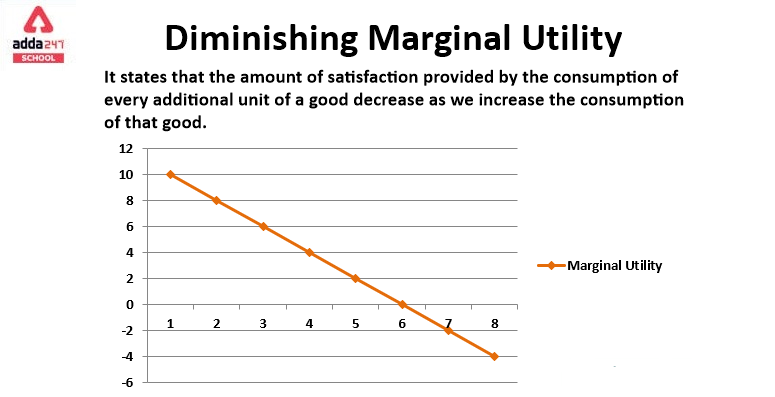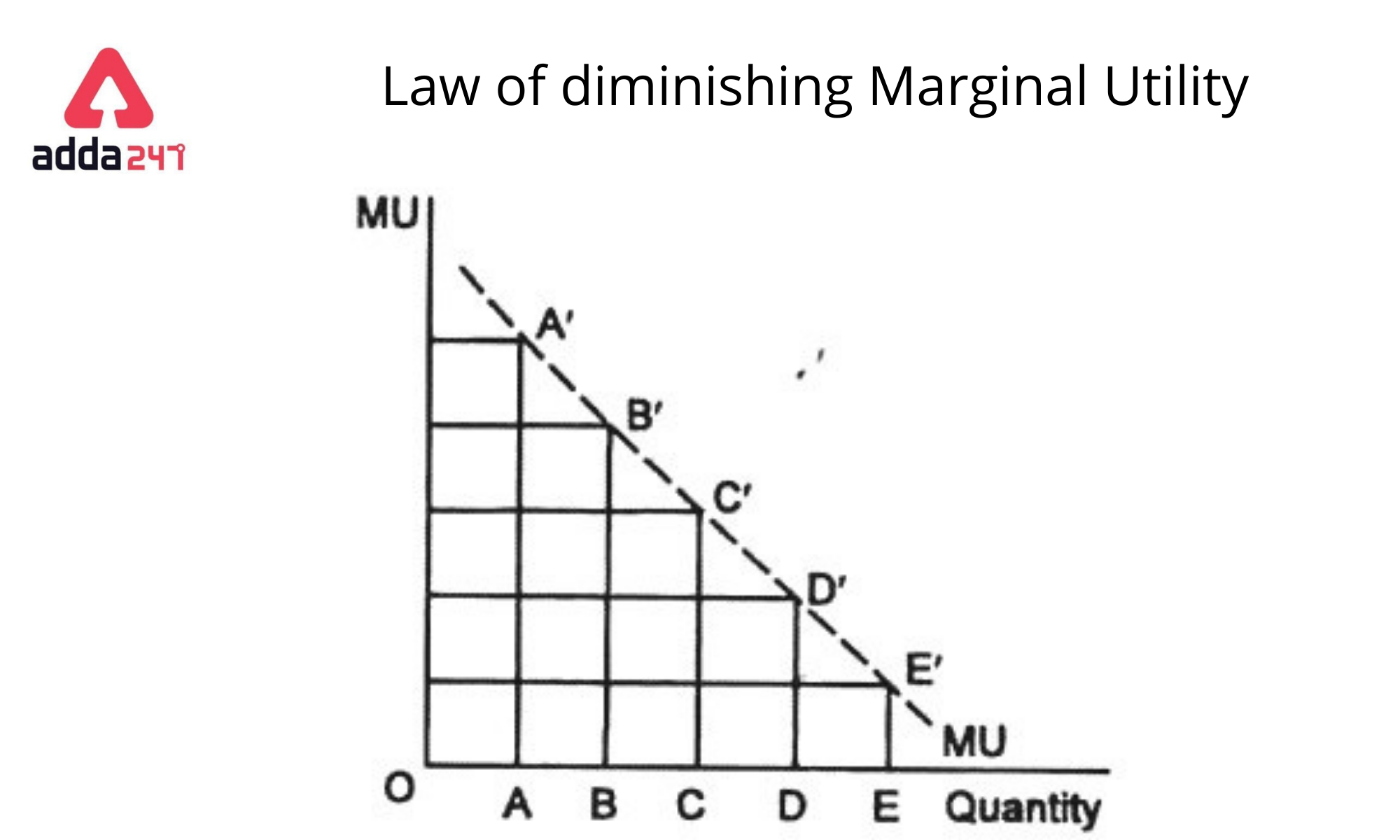Law of Diminishing Marginal Utility
In economics, utility refers to the pleasure or benefit received or lost as a result of a minor increase or reduction in consumption; hence, the marginal utility of a good or service quantifies how much joy or satisfaction is gained or lost as a result of a small increase or decrease in consumption. It could be either a positive, negative, or zero value. Purchasing more than one necessity, for example, provides minimal enjoyment because the customer perceives it as a waste of money, resulting in negative marginal utility. Extra consumption is negative if it causes harm, but it is beneficial if it provides some satisfaction. In other words, a negative marginal utility indicates that each additional unit of a good eaten causes more harm than good and so lowers overall utility, whereas a positive marginal utility indicates that each new unit consumed causes more benefit and thus raises overall utility.
Diminishing Marginal Utility
In the context of cardinal utility, economists propose a law of diminishing marginal utility, which states that the first unit of consumption of a certain good or service gives more utility than the second and following units, with the utility decreasing as the amount consumed increases. As a result, falling marginal utility refers to the decrease in marginal utility as consumption rises. Economists utilise this notion to figure out how much of a product a customer is willing to buy.
Law of Diminishing Marginal Utility with Diagram
law of diminishing marginal utility with diagram is given below.


Explain the Law of Diminishing Marginal Utility Based on PDF
The Law of Diminishing Marginal Utility is an economic principle that describes how the additional satisfaction (or “utility”) gained from consuming one more unit of a good or service decreases as more units are consumed. In simpler terms, the more you have of something, the less valuable each additional unit becomes to you.
Example:
Let’s take the example of eating slices of pizza. The first slice might bring you a lot of happiness (or “utility”). The second slice might also be enjoyable, but perhaps not as much as the first slice. By the time you get to the third or fourth slice, you might find that each additional slice is less satisfying than the one before it. Eventually, you may even reach a point where eating more actually makes you feel uncomfortable.
Graphical Representation:
In a graph, the utility is typically plotted on the vertical axis, and the quantity of the good or service is plotted on the horizontal axis. The curve initially rises but eventually starts to flatten out, indicating that while utility increases as you consume more of a good, it does so at a decreasing rate.
Mathematical Representation:
Mathematically, the concept can be represented by the function f(x), where
is the utility derived from consuming
units of a good. The marginal utility is then the derivative of this function,
. If
but is decreasing, then it obeys the law of diminishing marginal utility.
Implications:
- Consumer Choice: Understanding diminishing marginal utility helps explain why people diversify their consumption instead of buying lots of one item.
- Pricing Strategies: Businesses can use this principle to create pricing strategies like bulk discounts.
- Public Policy: It is also used in economics to justify progressive taxation and social welfare programs. Since an extra dollar is presumably worth more to a poorer person than to a richer person, redistributing income can increase overall utility.
- Resource Allocation: It also informs various types of economic behavior and decision-making, including how people allocate their time and resources.
Law of DMU
Alfred Marshall, a British economist, thought that the more of something you have, the less of it you want. Economists refer to this phenomena as diminishing marginal utility. The phenomenon of diminishing marginal utility describes how each extra unit of gain leads to a less and smaller rise in subjective value. Three bits of candy, for example, are preferable to two bites, but the twentieth bite adds little to the experience beyond the nineteenth (and could even make it worse). This phenomenon is so well-known in economics that it’s known as the “law of diminishing marginal value,” and it’s reflected in the concave shape of most subjective utility functions (Gossen, 1854/1983). This is the increase in utility that an individual receives as a result of increasing their consumption of a specific good. The concept of diminishing marginal utility underpins a wide range of economic phenomena, including time preference and the worth of things… The law states that as the supply of homogenous units grows (and vice versa), the marginal utility of each unit drops; second, the marginal utility of a larger-sized unit is greater than the marginal utility of a smaller-sized unit (and vice versa). The law of diminishing marginal utility is the first, whereas the law of growing total utility is the second.
Subjective value fluctuates most dynamically near zero points and soon levels off as gains (or losses) accumulate, according to the law of diminishing marginal utility. The concave curvature of most subjective utility functions reflects this.
Law of Diminishing Marginal Utility Given by
The Law of Diminishing Marginal Utility (DMU) was developed by HH Gossen in 1854. According to the Law of Diminishing Marginal Value, once a person consumes an item or a product, the satisfaction or value that they gain from the thing decreases as they consume more and more of it.
Explain the Law of Diminishing Marginal Utility Formula
Many economists, including Dr. Marshall, define the law of declining marginal utility as the additional benefit that a person obtains from a given increase in his stock of something diminishing with the increase in his stock that he currently has. Total Utility is an aggregate measure of consumer satisfaction, whereas Marginal Utility is a measure of the change in consumer satisfaction as a result of a change in consumption.
MU(x) = TU(x) – TU(x – 1)
The Marginal Utility received from the xth unit of consumption is equal to the difference between the overall utility acquired from x units of consumption and the total utility gained from x-1 units of consumption.
Law of Diminishing Marginal Utility State that
- The law of diminishing marginal utility asserts that, all other things being equal, as consumption rises, the marginal utility gained from each extra unit decreases.
- The incremental increase in utility that occurs from the consumption of one more unit is known as marginal utility. “Utility” is an economic phrase that means satisfaction or joy.
- The law of diminishing marginal utility states that as consumption grows, the marginal utility of each new unit decreases.
- As it becomes fully undesirable to consume another unit of any product, the marginal utility can fall into negative territory.
- As it becomes fully undesirable to consume another unit of any product, the marginal utility may decline to negative utility.
Law of Diminishing Marginal Utility Assumptions
The assumptions of the law of diminishing marginal utility are as follows:
- The quality of successive units of goods should be the same; changes in product quality may not be helpful in establishing the law.
- The use of commodities must be constant; any extended hiatus in consumption will change the legislation. Consumption units should be identical or homogeneous, that is, identical in every way.
- Units should be of uniform size and marginal. Consumer preferences should be consistent.
- The price of alternative goods should not fluctuate. If the costs of substitute commodities change, it may become impossible to predict the utility that the consumer will receive.
Law of Diminishing Marginal Utility Example
law of diminishing marginal utility examples are given below.
- When a consumer buys a bag of chocolate, their utility increases after one or two pieces, but after a few pieces, their utility begins to fall with each subsequent piece consumed, finally resulting in negative equity.
- Three pleasant bits are superior to two, but the twentieth mouthful adds little to the whole experience and may even worsen it.
Law of Diminishing Marginal Utility Statement
The law of diminishing marginal utility states that as we consume more of an item, the amount of satisfaction produced by each additional unit of that good declines. The change in utility gained from utilizing an additional unit of a product is known as marginal utility.
Related Post:









 CUET 2026 Free Batches Launched by CUET ...
CUET 2026 Free Batches Launched by CUET ...
 CBSE Date Sheet 2026 for Class 10 & ...
CBSE Date Sheet 2026 for Class 10 & ...
 CBSE Class 10 Date Sheet 2026, Check 10t...
CBSE Class 10 Date Sheet 2026, Check 10t...














